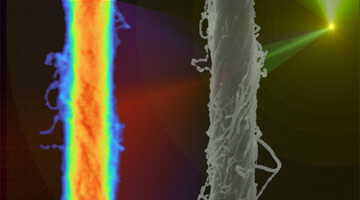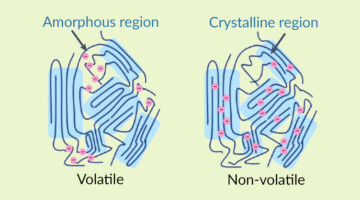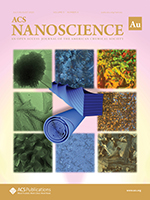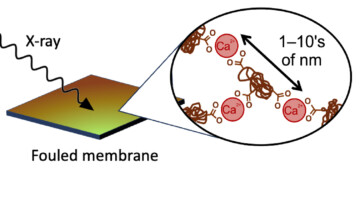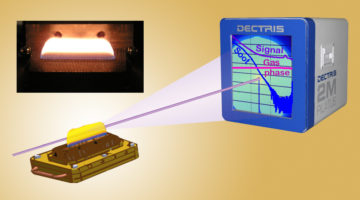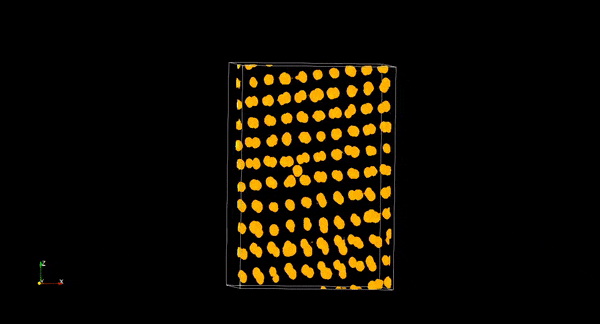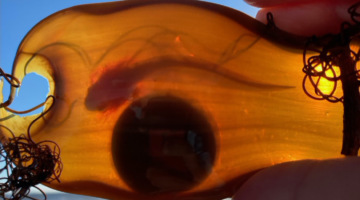Using the ALS, researchers found quantitative correlations between processing parameters and the structure of ultrafine, polymer-reinforced carbon-nanotube fibers. The work will facilitate the production of high-strength materials, including those needed for positioning target capsules for fusion research at the National Ignition Facility. Read more »![]()
![]()
An Organic Transistor That Can Sense, Process, and Remember
Traditional AI hardware employs physically separated information sensing, processing, and memory architecture, a configuration that suffers from large energy and time overhead. Now, researchers have fabricated an organic transistor device that can simultaneously act as the sensor and processing core of a streamlined AI hardware system. Read more »
Controlling the Structure and Morphology of Organic Nanofilaments Using External Stimuli
Coexisting organic helical and helicoidal crystalline nanofilaments formed by molecules with a bent molecular shape can now be transformed to a smectic liquid crystal phase or only helical nanofilaments by applying an electric field or irradiating the sample with UV light. Read more »
Keeping Water-Treatment Membranes from Fouling Out
When you use a membrane for water treatment, junk builds up on the membrane surface—a process called fouling—which makes the treatment less efficient. In this work, researchers studied how membranes are fouled by interactions between natural organic matter and positively charged ions commonly found in water. Read more »
Electric Vehicle Batteries Could Get Big Boost With New Polymer Coating
Scientists have developed a conductive polymer coating—called HOS-PFM—that conducts both electrons and ions at the same time. This ensures battery stability and high charge/discharge rates while enhancing battery life. The coating also shows promise as a battery adhesive that could extend the lifetime of a lithium-ion battery from an average of 10 years to about 15 years. Read more »
Surface Charge and Nanoparticle Chromophore Coupling to Achieve Fast Exciton Quenching and Efficient Charge Separation in Photoacoustic Imaging (PAI) and Photothermal therapy (PTT)
Organic semiconductor nanoparticles (OSNs) convert absorbed light into heat, and are commonly used in photothermal therapy and photoacoustic imaging. Here, the OAN, Y6, is shown to form strong intermolecular packing, manipulated by surface charge under restrained sizes, yielding new pi-pi stacking and fast exciton quenching. The temperature of the tumor area can rise to more than 70 degrees under NIR irradiation, which can effectively ablate a tumor. Read more »
Distinguishing Nanoparticles from Gas-Phase Species in Reacting Flows
Researchers developed a strategy for distinguishing between gas-phase species and newly formed nanoparticles in mixed gas- and particle-phase reacting flows. The approach uses small-angle x-ray scattering to study particle formation as it occurs by explicitly accounting for temperature-dependent scattering from gases. Read more »![]()
Versatile Sequential Casting Processing for Highly Efficient and Stable Binary Organic Photovoltaics
Ideal bulk heterojunction morphology is critical in organic solar cells (OSCs). Here, researchers show how sequential casting improves device performance in both fullerene- and nonfullerene-based systems, in which the donor and acceptor are deposited sequentially. The film spin-coating method is analogous to the traditional Chinese pancake-making process. Read more »
With a Little Help, New Optical Material Assembles Itself
Researchers have demonstrated that tiny concentric nanocircles self-assemble into an optical material with precision and efficiency. Electron microscopy and x-ray scattering revealed the structure and spatial distribution of each ingredient in the resulting materials. The new findings could enable the large-scale manufacturing of multifunctional nanocomposites. Read more »
How Shark Egg Cases Balance Toughness and Permeability
Also known as “mermaid’s purses,” shark egg cases are both tough and permeable—two opposing characteristics that are necessary for the embryo’s survival. X-ray scattering at the ALS and electron microscopy helped explain how the material’s nanoarchitecture contributes to its toughness, informing future development of high-performance synthetic materials. Read more »
- 1
- 2
- 3
- …
- 6
- Next Page »
